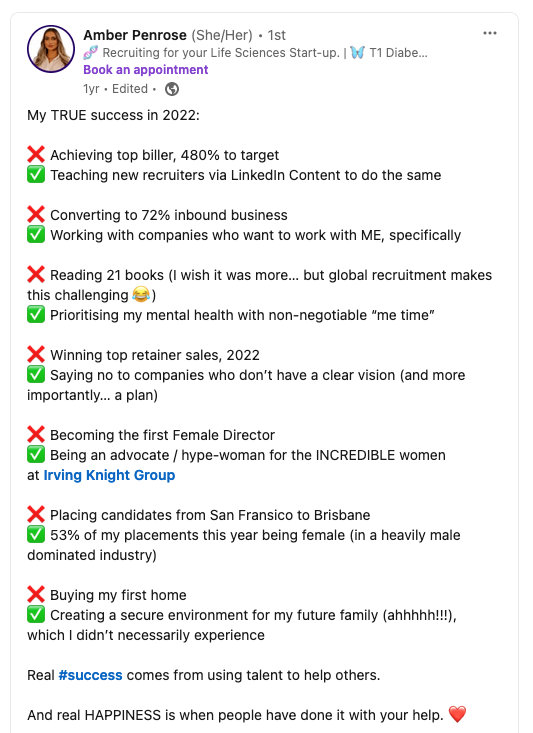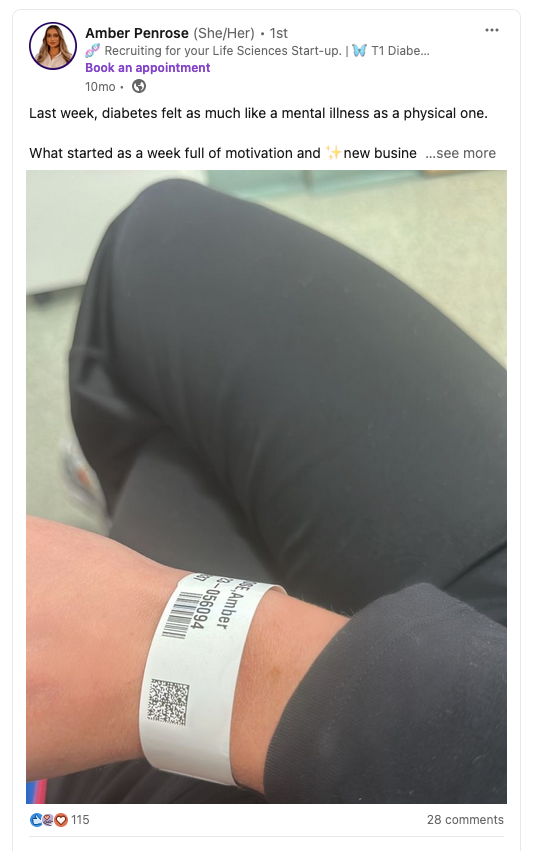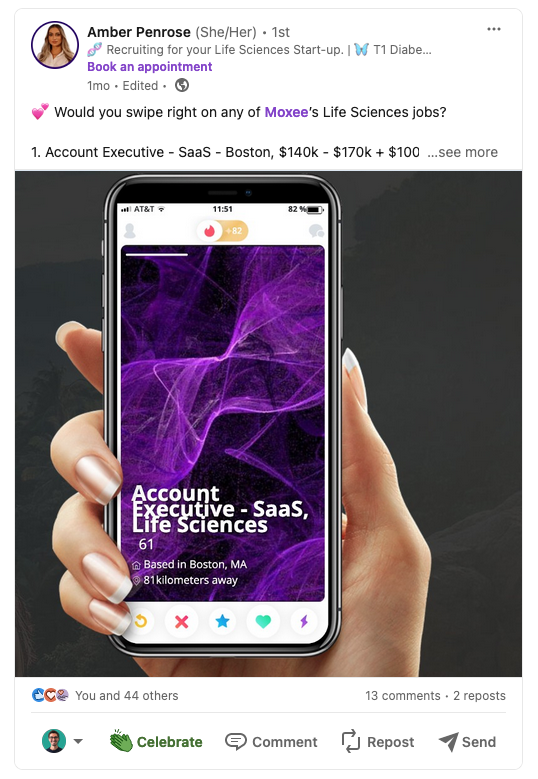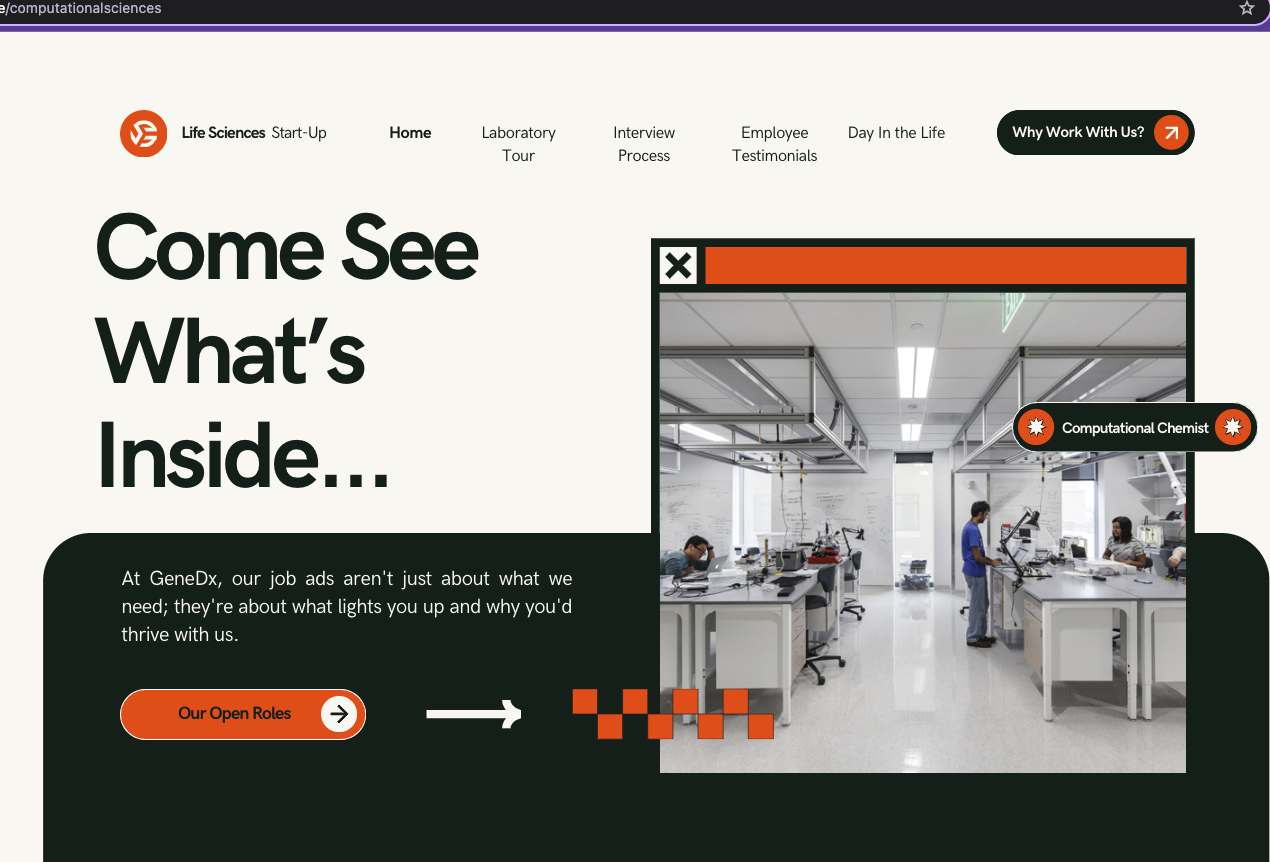Putting together the dream team is often what makes or breaks a start-up. But in the biotech world, the challenge is even greater because of one critical aspect: science.
Pick the wrong brain to lead your innovation, and you might as well hand over your best ideas to the competition on a silver platter.
Now, recruiters have long been the unsung heroes (or the necessary evil, depending on how you look at it) in this high-stakes game.
But let's face it: not all headhunters are created equal. And for startups buzzing with innovation, the old-school recruitment playbook just doesn't cut it anymore.
So to make sense of what works best in recruitment marketing, I decided to meet with one of the most inspiring recruiters I’ve seen: Amber Penrose.
In this article, I'll take you through the game-changing strategies Amber's deploying to not just fill positions, but to scout out the rarest of the talent.
But first, let’s start with the fundamentals.
What is recruitment marketing?
We often think of recruitment as a static process in which a company posts a job, waits for candidates to apply, selects a few to interview and then hires the one they think is best.
Paying to plaster your job ad across every digital billboard known to humankind might seem like a solution. And if you're a big-name brand, congrats, you might just get away with it. But for the under-the-radar companies, it's like whispering in the middle of a rock concert.
That’s where recruitment marketing comes in.
Instead of seeing recruitment as a mere job posting task, recruitment marketing focuses on building a strong recruiter brand that attracts talent BEFORE you even post a job.
How do you do that?
That's what I asked Amber Penrose.
“Biotechs typically tend to post job descriptions, not job adverts. They think they're both the same thing, but they're completely different. And especially for a startup, it's so important to be able to tell a candidate what that one thing is that makes you cool and really different."
Not thinking about recruitment marketing early enough can also be problematic for startups, as Amber pointed out:
“I find that around 50 employees is when people really start to reap the issues of not thinking about recruitment marketing sooner. And they really struggle. Most biotechs fail, and often a lot of it is because they can’t build the right team to bring their product or service to life. And I don't think this is thought about often enough.“
There's no one way to approach recruitment marketing, and if you ask ten different recruiters, you'll probably get ten different tactics for getting it right. However, one strategy that everyone seems to agree on is the use of social media, and LinkedIn in particular, to promote your recruiter's brand.
In this particular area, Amber has been a pioneer, and looking at her background may shed some light on what works best.
Meet Amber Penrose, recruitment marketing wizard
Amber began her headhunting career like most, starting at the bottom and working her way up the hierarchy to a senior position in a large recruitment firm.
During the eight years of her career, which spanned three recruitment agencies, she observed a significant gap in how large agencies served biotech startups.
“I really saw that startups weren't gaining value from these large agencies because they aren't built to support small businesses, they can't pivot at that speed, they can't offer flexible payment options that startups desperately need and they don't typically provide advice to support the business in regards to recruitment when you're not around. So typically the support is just sourcing and nothing else”.
This realization led her to establish her own recruitment agency, Moxee, about 10 months ago, primarily serving the US market, notably in Boston and California.
“Now with my own recruitment agency, I have a lot more flexibility, which is what I think startups in life sciences desperately need.”
What Amber means by flexibility is that while large recruitment agencies will most likely use the same posting and sourcing workflow for every position, her own small business can adapt to the challenge at hand with a customized workflow that leverages recruitment marketing when it's needed, or uses her headhunting skills when it's more relevant.
“For example, I am right now working on a computational chemistry role in a really remote location in Belgium. And as you can imagine, there are not many computational chemists chilling in the middle of nowhere in Belgium. So that was very much more a sourcing based role. So yes, I posted what I thought was a really good job description, but did I receive the right applicants? Absolutely not, because there were probably only three to exist anyway. So for a role like that, it's just who can I speak to and who might be able to relocate?”
For roles with a larger talent pool, Amber can rely more effectively on recruitment marketing to attract talent, but a good headhunting experience is still required to find the right person.
“If it were, let’s say, a molecular diagnostic sales role in San Francisco, there would be so many people. But in that instance, I still focus on sourcing because my niche is that I’m often brought on board for really tough-to-fill roles with a lot of specific skills that they’ve already tried to fill, but nothing has worked.”
The strength of Amber's strategy is that she can effectively combine both her sourcing skills and her recruitment marketing efforts.
At the heart of this strategy is LinkedIn.

Using LinkedIn as a recruitment marketing engine
Amber can easily point to her use of LinkedIn to build her own recruiter brand as the core of her success.
“So back in 2021, the pandemic happened, obviously, and all biotech recruiters were having the best time, but I just thought in my head, okay, Amber, what comes up must come down at some point. So what can I do to prepare myself for this time? And I'm so glad I started generating my personal brand on LinkedIn, because if I hadn't... My gosh, I'd be struggling right now.“
A key part of Moxee's strategy is to use LinkedIn not just as a networking platform, but as a powerful tool for generating inbound leads.
“My main achievements has been being able to garner 20,000 followers on LinkedIn and I'm now at a point where the majority of my business comes inbound.
In 2023, Amber was the top performer at a large recruitment agency, with 89% of her business coming from inbound leads, while no one else in the company had a single inbound lead out of 58 employees. She contrasts her success with the traditional recruiting model, which often prioritizes speed and quantity over quality and fit.

“Not only is it inbound leads I generate on LinkedIn, it's also people that align with my values, right? Because that's what my LinkedIn is about. It's about showcasing what I think needs to change within the biotech recruitment industry. And therefore the people that are reaching out to me are typically people that align with that as well. So it's just enabled me to do a lot less work and get a lot more value from my time.“
I was curious to know more about Amber’s LinkedIn workflow and was happy to see similarities with my approach of building a routine and batching activities to make sure it’s as time-effective as possible.
“On Sunday evening, I try and write as many posts for the week as possible. Per week, I probably spend an hour and a half writing. Once you have the idea and once you have the hook and the call to action, I think filling in the middle part is fairly easy. It's just coming up with the idea that's time-consuming.”
To help with this, it may be helpful to have a defined theme for each day.
“On Sundays, I always do something personal. Saturdays are always diabetes-related (I have type I diabetes). Mondays are about lessons I learned while building my company. Tuesdays might be something cool that a biotech company is doing when it comes to recruitment. I think having some sort of calendar does help for those days where you sit down and you're just like, what the hell do I post about today?”

Another trick Amber taught me is to record your calls during the week with an automated transcription tool, and then feed the transcript to an AI chatbot to come up with ideas.
“I can just put all my calls from the week in ChatGPT and be like, okay, what's been on my client's minds this week? What should I post about to add value to them? And that's something I do a lot every week.“
Finally, remember that LinkedIn favors two-way interactions, and commenting on others’ posts might be as important as writing your own posts.
“I now have to block out time every morning from 9:30 to 10 a.m. to focus on LinkedIn commenting and engaging because if I don't time block, I could do that all day and I've definitely made that mistake. And as you can imagine, as a recruiter, there's no way of avoiding LinkedIn. But I don't think you need to spend any longer than 15 minutes per day, maybe try to comment on five posts, ideally.“
Amber is not only a growing figure in the LinkedIn biotech community, she also has a style that brings a fresh perspective to the industry and experiments with formats that are not so common.
Innovating in recruitment marketing
Amber Penrose is flipping the script on the way recruiting is done on LinkedIn, especially in the buttoned-up world of biotech. While most would tread cautiously, sticking to the professional and polished, Amber dances on the edge with memes, splashes of color, and videos that feel like you're catching up with an old friend rather than being sold to. It's a breath of fresh air in a landscape that often feels too stiff for its own good.
Now, let's talk about her Valentine's Day post—pure genius. Imagine swiping through a Tinder-like carousel, but instead of potential dates, it's job positions flirting with you. It's not just clever; it's strategic. Amber's using the language and tools of our everyday digital lives to make job hunting relatable, even fun.

“Something that I see on LinkedIn from a lot of recruiters is just the same post, so I thought, okay, how can I make this a bit more fun? And I received so many referrals for those roles, just because people were like, this is such cool graphic design, or, this is something slightly different. Someone even messaged me and gave me a referral for a lady who didn't even have a LinkedIn profile. So if I hadn’t done this, I might not have found this lady.“
Her creativity goes beyond LinkedIn. She’s also been experimenting with mini-websites that showcase a company’s culture to potential applicants.
“I didn't know that you could create websites on Canva until about a few months ago and I've been having the best time. For a startup I’ve been working with, I created a careers page that starts with an interview with the CEO about why he started the business, why people love working there, what kind of work they're doing, and their value proposition. And yeah, it's just been amazing to be able to have something a bit more fun and interactive“

Amber's knack for shaking up the recruitment scene isn't just for show; she’s setting new benchmarks in the hiring world, particularly in the biotech sector where time is often of the essence. By employing creative tactics, she has been able to significantly reduce hiring timelines for her clients, with one notable example reducing the average time to hire from 98 days to 27 days.
At the core of this impressive result stands her own personal brand.
Using personal branding in recruitment marketing
What really surprised me in my interview with Amber was not only the fact that her recruitment marketing techniques were paying off, but also that her own personal branding was having a ripple effect on the companies she worked with.
“I went on a marketing podcast for biotech, and there was this lady listening to this podcast that I never met before. It weirdly turns out that she was moving from France to Zurich in a couple of months and I was recruiting for a position in Zurich at the time. I ended up hiring her for this role but without this podcast, which was not related at all to the position, I wouldn't have known that she had existed and would never have known that she was going to move from France to Zurich. So it was just such a weird series of events. And then, the fact that she was actually the one that got hired in the end was just mind-blowing to me.”
Another aspect of Amber's experience that resonated with me is the fact that the scale and impact of social media in recruitment marketing completely overshadows more traditional avenues such as event marketing.
“Last year, I had 7 million impressions on my LinkedIn posts. Even if I went to every single biotech conference in the whole world, which I would never have the opportunity to do anyway, I wouldn't be able to spread my message to 7 million people. So I just think there's such a missed opportunity for biotech companies.”
And for those who still believe in the power of event marketing, a strong personal brand can take your conference experience to another level, as Amber recently discovered.
“I am by no means a big person on LinkedIn, but 20,000 followers in life sciences is actually quite a lot. And I went to Bio Europe last year and I'm not joking, I felt like a celebrity. I had random people coming up to me saying, are you Amber? And I was like, yeah, who are you? It is the most amazing feeling because conversations start themselves. I don't have to do the awkward things like going up to someone's booth and telling them I'm a recruiter. It really made me realize that all the time I put into LinkedIn was worth it."
This isn't just about being known in the industry; it's about creating a platform where the mere association with her brand elevates her clients in the competitive biotech landscape.
And this is something the big, clunky recruitment firms can’t even dream of pulling off.
Through her LinkedIn presence, Amber builds an overlapping audience of people who are interested in what she has to say, but also potentially interested in the job opportunities she is promoting for her client.
This indirect value creation is proof of the power of personal branding in today's digital age, where connections are made not only through formal introductions, but also through the stories we tell and the presence we cultivate online. Amber's story underscores how a recruiter's personal brand can be a critical factor in not only attracting talent, but also enhancing the appeal and credibility of the companies they represent.
For me, this is a lesson that every biotech company should learn.
And it's not just about hiring a recruiting master like Amber.
Building a strong personal brand, for example around the company's CEO, is a sure way to have a positive impact on the company's brand.
I strongly believe that biotech executives who can build a strong personal brand will have an advantage when it comes to recruiting.
Examples are starting to emerge on LinkedIn, and from the few conversations I have had with such CEOs, their efforts are paying off big time in attracting the best people.
People connect with people, not just with companies. A CEO or executive with a strong personal brand can connect with audiences in ways that corporate accounts cannot. They can tell the company's story, share insights, and discuss industry trends, fostering a community of followers. This community naturally extends its interest to the company, creating a pool of potential candidates who are already aligned with the company's vision and culture.
As Amber pointed out, recruiting doesn't have to be a boring task you outsource to someone else.
Building authenticity and transparency may not be what biotech companies are used to, but in the long run, those who are able to take the risk and experiment with new recruitment marketing ideas may be the ones who build the best teams.
And as we all know, that counts for a lot in science.






